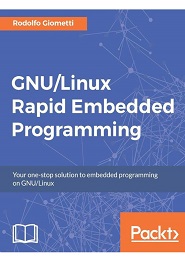
English | 2017 | ISBN: 978-1786461803 | 660 Pages | PDF, EPUB, AZW3 | 52 MB
An annotated guide to program and develop GNU/Linux Embedded systems quickly
Embedded computers have become very complex in the last few years and developers need to be able to easily manage embedded computer projects by focusing on problem solving; they should not have to waste time finding supported peripherals or learning how to manage them. This book shows you how to interact with external environments through specific peripherals used in the industry. It focuses on the latest Linux kernel release 4 and Debian/Ubuntu distributions (with embedded distributions such as OpenWRT and Yocto).
This book presents popular and user-friendly boards in the industry – such as Beaglebone Black, Atmel Xplained, Wandboard, and system-on-chip manufacturers – and lets you explore corresponding projects that make use of these boards. You will first program the embedded platforms using the C, Bash, and Python/PHP languages in order to get access to the external peripherals. You will gain a strong foundation in using embedded systems by learning how to program the device driver and access the peripherals. You will also learn how to read and write data from/to the external environment by using C programs or a scripting language (such as Bash/PHP/Python) and see how to configure a device driver for specific hardware.
The final chapter shows you how to use a micro-controller board – based on the most used microcontroller – to implement real-time or specific tasks that are normally not carried out on the GNU/Linux system. After finishing this book, you will be capable of applying these skills to your personal and professional projects.
What You Will Learn
- Use embedded systems to implement your projects
- Access and manage peripherals for embedded systems
- Program embedded systems using languages such as C, Python, Bash, and PHP
- Use a complete distribution, such as Debian or Ubuntu, or an embedded one, such as OpenWrt or Yocto
- Harness device driver capabilities to optimize device communications
- Access data through several kinds of devices such as GPIO’s, serial ports, PWM, ADC, Ethernet, WiFi, audio, video, I2C, SPI, One Wire, USB and CAN
- Practical example usage of several devices such as RFID readers, Smart card readers, barcode readers, z-Wave devices, GSM/GPRS modems
- Usage of several sensors such as light, pressure, moisture, temperature, infrared, power, motion
Resolve the captcha to access the links!